
The “Belt and Road” and Gourd Culture
On July 6, 2018, an article entitled The "Belt and Road" and Gourd Culture by Hu Lu was published inGuangming Daily. The article said that the Chinese people love the gourd, so do the people in countries along the "Belt and Road”. It is generally believed that the origin of the gourd is Africa, and there has been a long history for the Chinese and African people to grow gourds. At the same time, historical documents show that like the Chinese, the Indian people have the same understanding of the cultural meaning of "multiple sons and grandchildren" conveyed by the gourds. Gold Eagle, the folktale of Mongolia, also shows that gourd is an embodiment of breeding. As daily necessities and auspicious handicrafts, the gourd is loved by people from all walks of life in countries along the “Belt and Road”. The Afghans have the habit of making cosmetic containers and snuff bottles out of gourd on festive occasions. In Israel, Turkey and some Arab countries, gourds are commonly used as smoking sets and decorative handicrafts. Gourd culture also boasts a long history in the United States, Japan, and South American countries.
On July 30, 2018, the Gourd Culture Series compiled by Hu Lu was published by Zhonghua Book Company, and he was invited to attend two publishing ceremonies respectively in Huludao during the Ninth China International Gourd Culture Festival, and in Rizhao, the East Bridgehead of the New Asia-Europe Continental Bridge and a key node of the "Belt and Road".
The preparation of the compilation of the Gourd Culture Series began in the autumn of 2015. It took three years for more than 130 experts and scholars to participate in the work. The series are divided into 9 volumes, such as The Volume of Research, The Volume of Historical Materials, The Volume of Literature, The Volume of Dongchangfu and so on. Lulu and his colleagues have expanded the gourd research to hundreds of countries and regions in Asia, Africa, Europe and America. It is a pioneering project to use language to record the 7,000 years of gourd culture history.
What Hu Lu is doing is to promote the Gourd Culture Series to the countries along the "Belt and Road" and other countries that love the gourd culture through the “Glamour of the Gourd --- Gourd Culture Tour along the Silk Road”.
Thousands of gourds from home and abroad
The preparation of the Gourd Culture Museum was started in 2010. At the beginning, the gourds were stored in the study, and later with the increase of the collection, the gourds were stored in the bedroom, living room, sofa, balcony, and corridor, and consequently the living space of Hu Lu was completely filled. However, there are more and more gourds coming. The idea of building a Gourd Culture Museum occurred to Hu Lu.
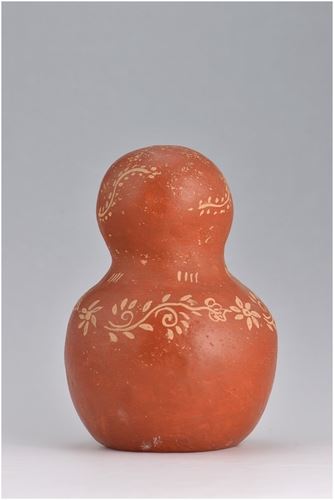
The reporter asked Hu Lu how many gourds he had collected in these years. Hu Lu answered, “thousands of gourds of nearly one hundred species, more than 100 volumes (pieces) of gourd culture books and audio-visual materials, and gourd artworks from more than 70 countries and regions.”
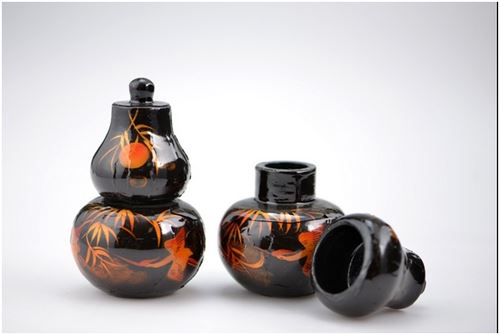
The reporter visited once the Gourd Culture Museum. It was amazing. The biggest gourd was taller than the reporter, the smallest one as big as a thumb. Staying with so many gourds of various shapes and sizes, you could meditate as if you could have a good communication with them. These gourds are collected in countries such as the United States, Canada, Mexico, Brazil, Japan, South Korea, Turkey, Israel, Sudan, Vietnam, Russia, Italy, Mali, New Zealand, Kenya, South Africa, Serbia, Argentina, Peru and so on.
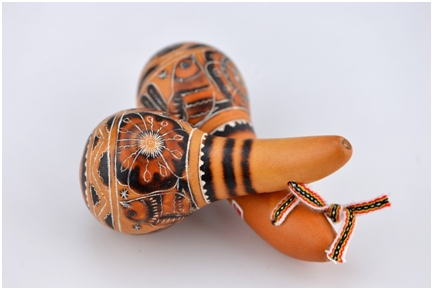
Hu Lu said, "What I value more is the folk culture contained in different gourds. Through the gourd cultures around the world, we can have a glimpse on the folk culture of different nationalities. Therefore, collecting gourds is a way to understand the world and to promote the cultural exchanges of different nationalities.”
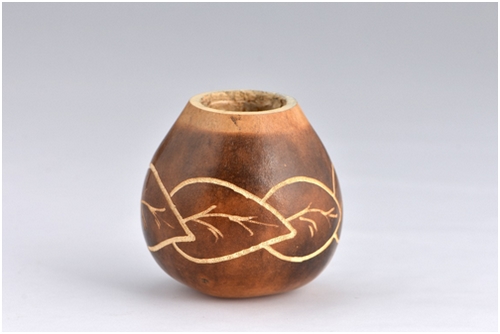
ge, there hung a few gourds, but these gourds are not for sale. For several times, Hu Lu visited the owner — an elder man with grey hair. Because of the language barrier, Hu Lu could only express his thoughts in exaggerated body language, and the elder man could not help but laugh.
Finally, the elder man was clear of Hu Lu’s intention. At that moment, Hu Lu suddenly realized that the small gourd allowed two people from different countries to cross cultural barriers and eliminate each other's strangeness. In the end, the elder man was moved by Hu Lu’s sincerity and persistence, and agreed to sell at a high price the set of gourd utensils that had played an important role in Korean farming culture. And now, these gourds are stored in the Gourd Culture Museum.
On October 27, 2018, a delegation of experts and scholars from Korea visited the Gourd Culture Museum. Hu Lu showed the Korean friends his collections including special-shaped gourds, knotted gourds, long-stemmed gourds, egg-gourds, as well as chess pieces and instruments made of gourds.
In front of a group of clay sculptures titled “Life Accompanied by Gourds”, Hu Lu introduced in detail the gourd elements of folk culture. At different stages of life, a person is accompanied by different customs of the gourd culture, thus reflecting the unique status of a gourd in the folk culture. The Korean friends were greatly fascinated. On seeing a scene showing a Korean custom of trampling on gourds in a Korean wedding, everyone exclaimed with excitement.
A group of Lahu people clay sculptures characterized with gourd elements attracted the attention of the delegation headed by Cao Mingquan, Director of the South Korean Xinhua News Agency. Hu Lu introduced the gourd culture of the Chinese Lahu people to the guests. The Lahu people claim that they “have originated from the gourd”, and their first ancestors were born from the gourd. They have a traditional musical instrument, Lusheng, which Lahu boys learned to play from the age of six, and accompanied all their lives.
Together, Hu Lu and the delegation also played the Lusheng. While they were playing, they were acting out scenes of the Lahu people working on the farmland. Here, the gourd helped people cross cultural barriers and become friends.
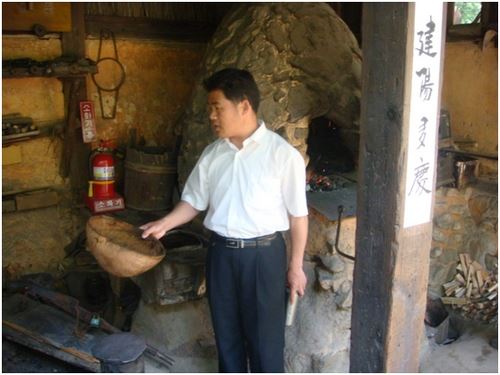
The name of Association for All Nippon Gourd Fanciers in relation with The Analects of Confucius
The gourd has helped Lulu and overseas gourd researchers bridge the gaps. Foreign friends like Bill Ivey, President of the American Gourd Society, Tim Royd, Executive Director of the American Folklore Society, Krasniv, Vice President of the Russian State University for the Humanities (Moscow), Professor Martin Russii of the University of Birmingham in the UK, Tsutomu Tokida, President of Association for All Nippon Gourd Fanciers, Lee Young Koo, President of the Global Cultural Industry Association in South Korea, and Zeng Fanru, President of Singapore China Friendship Association in Singapore have visited the Museum and talked with Hu Lu about culture and folklore.
Among them, Tsutomu Tokida, President of the Association for All Nippon Gourd Fanciers visited the Gourd Culture Museum in Qufu in March 2013. With his introduction, at the invitation of the 39th General Conference of the Association for All Nippon Gourd Fanciers, “Glamour of the Gourd --- Gourd Culture Tour along the Silk Road” entered Japan in June 2014.
In May 2015, again Tsutomu Tokida headed a delegation to visit Gourd Culture Museum in Qufu. This time he gave a special gift to Hu Lu, a picture named Confucius and His Teachings, illustrated with “What Yan Hui eats is a small basket (“箪” in Chinese or “Dan” in Chinese pinyin) of rice, what he drinks is a ladle (“瓢” in Chinese or “Piao” in Chinese pinyin) of water and where he lives is a poor house. No one else can bear such poverty and hardship. Despite the unfavorable living conditions Yan Hui still persists in his learning.”
ciers, Tsutomu Tokida explained that in Japan, gourd is not called “Hu Lu” but Hoytan (“ヒョウタン” in Japanese, “瓢箪” in Chinese, or “Piao Dan” in Chinese pinyin), where the character “瓢”( Piao) in “爱瓢会” (Association for All Nippon Gourd Fanciers) is also selected from the phrase “a small basket (Dan) of rice and a ladle (Piao) of water” in The Analects of Confucius.
China and Japan, Hu Lu said, are neighbors that are closely related in culture, society, ideology and many other aspects. The thoughts of Confucius like virtue, benevolence, rite, honesty, righteousness and wisdom, in particular, had a profound influence on Japan's politics, law, literature, philosophy, religion, art, etc., which greatly accelerated the progress of civilization in Japan. And the story of “a small basket of rice and a ladle of water” is a good example of sticking to one’s ideal and enjoying life in unfavorable conditions, which is also shared by intellectuals both in Japan and China.
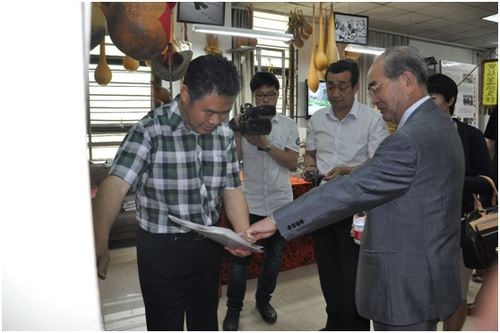
Gourd Class in Canada
On November 30, 2017, the “Glamour of the Gourd --- Gourd Culture Tour along the Silk Road” entered Canada. At the Confucius Institute in New Brunswick, Professor Hu Lu gave a keynote speech on “Gourd Culture and Confucian Culture”.
Hu Lu started with a gourd ladle. He said that a gourd is called a ladle when it is split into halves. As for the ladle, Hu Lu told the story of “a small basket (Dan) of rice and a ladle (Piao) of water” in The Analects of Confucius. It’s about how Yan Hui, Confucius’ favorite disciple studied hard 2500 years ago. Yan Hui lived a simple life in an alley of Qufu, eating with a bamboo utensil (Dan) and drinking with a ladle, which was unbearable for others. However, in the circumstances, he followed his master Confucius, studying assiduously. Eventually he made brilliant achievements. Hu Lu told the students at the Confucius Institute that nowadays our material life is no longer as deficient as that of Yan Hui’s time, nor should be our cultural life. Everyone is sure to learn Chinese and Chinese culture well as long as he is keen on learning and insatiable in learning and learns in a down-to-earth way.
Then he said that gourds are divided into sweet and bitter gourds. Youfeng in The Book of Songs reads, “Eat melon in July, and pick gourd in August.” Here eating melon in July means that the sweet gourd can be eaten in the seventh lunar month, while the bitter gourd cannot be eaten in large quantities. Otherwise, poisoning might occur. There is a story about the bitter gourd in The Analects of Confucius. Yang Huo in The Analects of Confucius reads: Am I a bitter gourd that can only be used as an ornament instead of food that can be eaten?”
The humorous story aroused laughter. Ms. Kimberly, the Canadian education official shared pictures in her mobile phone of her husband’s gourd works with Hu Lu and exchanged her experience of gourd art creation with him.
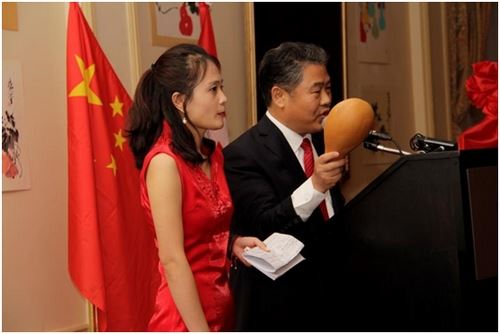
Echo Transcending the Oceans
Just in the middle of the speech by Hu Lu, Ms. Kimberly, an official in the New Brunswick Department of Education said that her husband John Bauer taught French at an elementary school, and his father Loved to grow gourds, so her husband painted on the gourd from an early age.
In July 2018, a principal delegation headed by Teng Jing, the dean of the Confucius Institute in New Brunswick, Canada, visited Qufu Normal University. The principals were fascinated by the gourds of various sizes and shapes in the Gourd Culture Museum. When Jing Qing talked about the gourd works by the French teacher, Hu Lu expressed his desire to purchase them. After Teng Jing returned to Canada, she conveyed to Kimberly, the wife of John Bauer, the desire of Lulu to purchase John’s works. She smiled, “No, it is not for sale, but we can give it to Mr. Hu Lu.
The night before Teng Jing went to China in this early August, Kimberly, together with her husband John Bauer and their son, came to Teng Jing’s home with a box containing two exquisite gourds, each being 10cm high. According to Kimberly, the colored one was made by John and the green one was made by John’s father who was a professor at UNB University and fond of planting gourds and painting on them in his spare time. At that time, John said humorously, “I used to regard my father as the king of gourd, but now I think Hu Lu from China is the real king of gourd.”
Regrettably, John's father died in 2010 and could not see the Chinese gourd. When John’s mother heard that John’s gourd would be taken to China, she drove from another city to her son’s home and brought the work of John’s father
They also wrote a card containing a line of famous American writer Kurt Vonnegut, “The little things in life are big things. ”
In August 10, Teng Jing went to China. She carried the box in her handbag and opened it from time to time to see whether the gourds were in good condition. In Qufu, Teng Jing attended the First Global Confucius Institute Shandong Cultural Tourism Summit where she told the guests from five countries the story of the two gourds.
When leaving Qufu, Teng Jing presented the two exquisite gourds to Hu Lu and his wife, and the couple presented in return a magnificent gourd painting they had created, hoping that Teng Jing would take it to John Bauer.
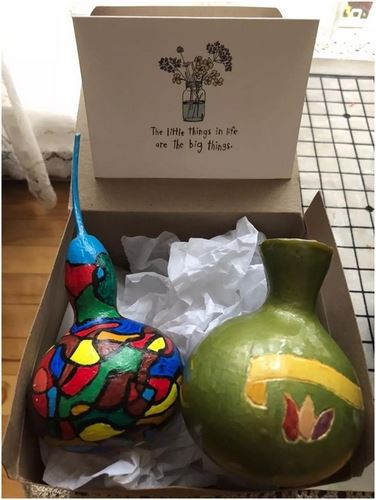
Gourd Broken, Friendship Remains
In December 2017, At the invitation of Missouri State University, Hu Lu held the “Glamour of the Gourd---Gourd Culture Tour along the Silk Road” Exhibition. Mr. Conan, First Vice President of American Gourd Society, Ms. Waterman, President of Missouri Gourd Society, and American gourd culture lovers attended the event.
When meeting Mr. Conan who is more than 70 years old, Hu Lu felt he met an old friend. When the interpreter explained that Conan had flown more than two hours to Missouri and driven another four hours to meet Hu Lu, whom he had never met before, they hugged each other, regretting that they had got to know each other so late. During the conversation, Conan was so excited that tears filled his eyes several times.
Conan recalled his journey to China exploring gourd culture, in which he learned that the gourd in China not only symbolizes happiness, but also helps people to gain happiness. In China’s history, the gourd can find its use in lots of aspects, and several centuries ago, they were made into a variety of things such as bowls, vases, cricket cages, instruments and figurines.
Many gourd artists who had heard the news also came to the exhibition. After the exhibition, Hu Lu decided to buy some gourd artworks and take them back to China in order to express his gratitude to the artists who had come all the way to participate in the exhibition. His colleagues explained that gourd artworks were liable to damage in the transportation because of their large sizes and delicate handicraft and advised him not to buy them. Hu Lu insisted to buy four gourd artworks.
He wrote letters to the owners of American gourd works in order to ensure the safe arrival of gourds in China. When they learned that it was expensive to send the gourds by post from the United States to China, the gourd owners persuaded him to give up the purchase and they would return the money they had received. Hu Lu remained determined to buy the gourd works.
After waiting for two months, Hu Lu received two of the gourd works. He opened the box happily and checked them. Unfortunately, one of the hollow gourd works, whose shell was thin after being crafted, had been broken in several places. Hu Lu felt painful as if his own child got hurt. Chinese logistics company agreed to negotiate with the American one about compensation. Because of the fact that the box was not broken and the outer package was complete, the logistics companies did not take on the responsibility. The owner of the broken gourd in the United States felt very sorry when he heard about it. He said very sincerely that he would pay the postage. Hu Lu answered him humorously, “It does not matter. Although the gourd work is broken, the story of it is of great significance.” He paid the fee to the logistics company right away. Another two gourd works soon arrived in China. Although the same case occurred, Hu Lu insisted on paying the postage. The owner of the damaged gourd was so moved that she wrote that she would make another exquisite gourd work for him and pay the postage herself...
After being repaired, the gourd works are as beautiful as they used to be. The cracks are visible only when you look at them closely.
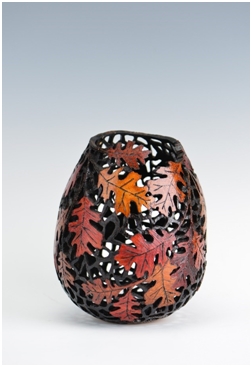
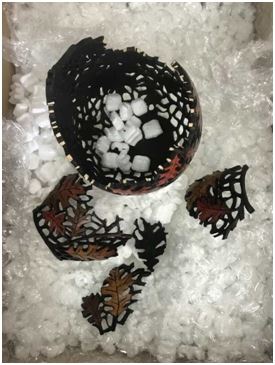
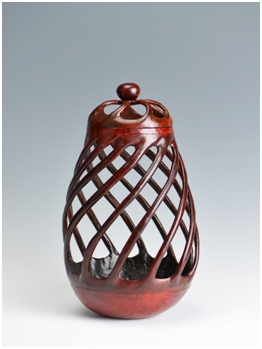
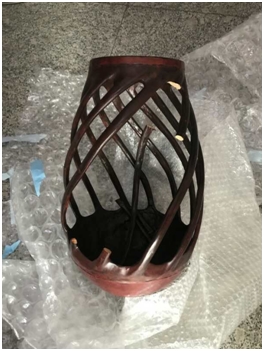
Valuable Gourd Musical Instruments in Africa
There are hundreds of kinds of gourd musical instruments in the world. Hu Lu wants to show people gourd musical instruments having been collected in China and other countries through the exhibition of “Glamour of the Gourd — Gourd Culture Tour along the Silk Road.” The idea of African gourd musical instruments initially occurred to him.
According to Hu Lu, gourd musical instruments and utensils are the major components of African gourd culture. For example, a maraca is a musical instrument made from gourd. A layer of glass beads or shells is inlaid in the surface and holes are cut in the bottom through which loud and powerful sound can be produced that demonstrates the strong physique and profound gourd culture of African people, just like gourd containers on their heads.
As early as in 2010, Hu Lu started collecting African gourd instruments when his friend helped him to collect a Kenyan Mbira at the African Pavilion of the 2010 Shanghai World Expo.
In April 2016, Hu Lu attended the Gourd Festival, a traditional festival of the Lahu people in Lancang, Yunnan Province, China. at the very sight of African maraca performance in the gourd festival, Hu Lu was determined to buy and collect this maraca. Unfortunately, it was used only for performance instead of for sale during the festival. In the end, the African friends were moved by his sincerity and sold him the African gourd maraca.
In 2017, some friends in Africa helped Hu Lu find the musical instruments he had desired. The four musical instruments including African xylophone, kora, djembe and mbira took gourds as the main component and produced wonderful sound with the natural shape of the gourds to form resonance.
2017 witnessed Hu Lu’s harvest of the collection of African gourds. In this year, with the help of his friends in Africa he also found a sub-waist gourd on whose surface a map of Sudan in green was carved.
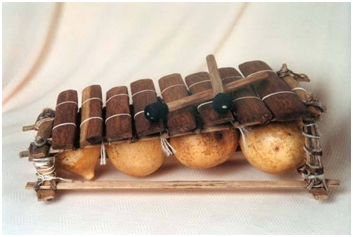
Telling the story of Chinese gourd
The gourd is one of the oldest plants in the world, and it has long been bonded with countries along the Belt and Road. Silk, porcelain and tea, the main products in foreign trade along the ancient Silk Road, are symbols of the popularization of Chinese civilization. Porcelain was proved by historians to have evolved from pottery made by the Chinese as early as Neolithic Age, and from the shape and function of the early potteries one can see the designers’ inspiration from gourd. Hu Lu noted, “the natural and elegant outline of gourd makes it a perfect embodiment of harmony, which also conforms to the concepts of “appreciating and pursing harmony”. The Chinese pronunciation of gourd sounds like “fu lu” (happiness and wealth), representing the Chinese people's yearning for a better life, condensing the essence of Chinese traditional culture and national cultural genes, and is highly compatible with the idea of ‘constructing a community with a shared future for mankind’. ”
Hu Lu said that five years ago, President Xi Jinping inspected Qufu and made an important speech on promoting China's excellent traditional culture, which made us very excited. As a scholar focusing on gourd culture study in a university in Confucius’ hometown, Hu Lu believes he should consciously take up the responsibility of carrying forward the excellent traditional culture of China and deepen and globalize the study of Chinese gourd culture, telling the perfect Chinese gourd stories.
On September 23, 2018, the “Glamour of the Gourd --- Gourd Culture Tour along the Silk Road” once again went abroad and came to the Republic of Maldives. Maldives is an island country in the Indian Ocean and is one of the ten countries in South Asia along the “Belt and Road” . The tour in Maldives focused on the recent publication of the gourd Culture Series, the application and evolution of the material form of the gourd in the process of Chinese civilization inheritance, the cultural attributes endowed by the Chinese traditional culture, and myths and legends accompanied people's work and life. The audience were deeply impressed by the hard work and wisdom of the Chinese nation and attracted by the charm of Chinese traditional culture.
The reporter learned that “Glamour of the Gourd --- Gourd Culture Tour along the Silk Road” had also entered Japan, Belarus, Russia and other countries, wherever they went, they highly attracted local gourd culture lovers and artists.
anities of Eurasian Economic Union, the “Glamour of the Gourd --- Gourd Culture Tour along the Silk Road” will soon enter Belarus along the "Belt and Road” again. The Tour was planned to be held in Belarus Nation Grand Theatre in mid-November in 2018, and a ceremony of presenting the Gourd Culture Series to the Minsk Chinese Cultural Center in Belarus would be held. Subsequently, the “Glamour of the Gourd --- Gourd Culture Tour along the Silk Road” will enter Serbia, Bosnia and Herzegovina, Kyrgyzstan, Israel and so on.
。
Actions speak louder than words. However, it is difficult to act to go global. In the process of going global, Hu Lu have overcome all kinds of difficulties with the wisdom and energy endowed by the gourds.

版权及免责声明:凡本网所属版权作品,转载时须获得授权并注明来源“粤港澳头条”,违者本网将保留追究其相关法律责任的权力。凡转载文章,不代表本网观点和立场。